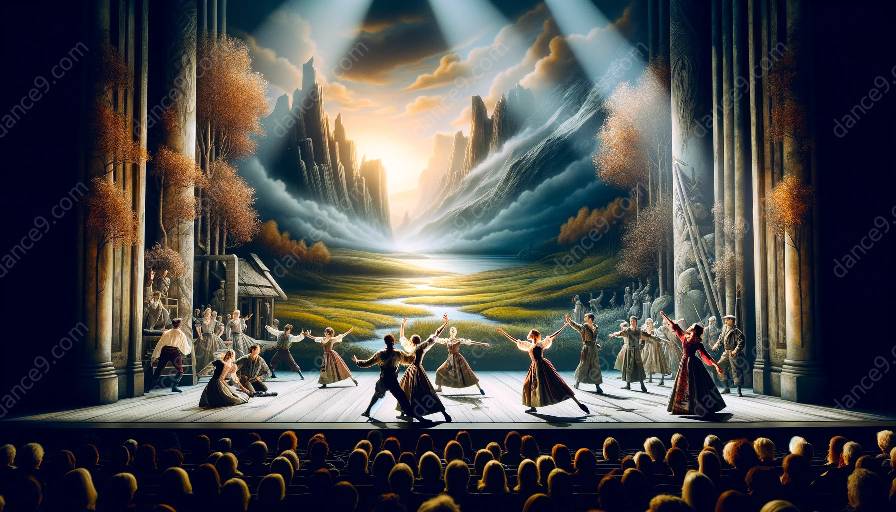Dance has long been a powerful medium for storytelling and artistic expression. Within the realm of dance, narrative choreography plays a pivotal role in shaping and communicating stories, emotions, and concepts. Furthermore, the representation of gender in dance has been a subject of significant discourse, reflecting societal attitudes and evolving cultural perspectives.
As we delve into the intersection of narrative choreography and gender representation in dance, we uncover an intriguing tapestry of artistic innovation, social commentary, and personal expression.
Narrative Choreography: Capturing Stories through Movement
Narrative choreography is a dynamic form of artistic expression that amalgamates storytelling with movement. It provides dancers and choreographers with a platform to encapsulate narratives, themes, and emotions through the physical language of dance. In this context, choreography becomes a vehicle for conveying intricate stories, whether drawn from literature, personal experiences, historical events, or societal dynamics.
One of the distinctive features of narrative choreography is its ability to communicate abstract concepts and evoke powerful emotions through non-verbal means. By manipulating the dynamics of movement, space, and music, choreographers can construct cohesive narratives that resonate with audiences on a profound level. This form of choreography transcends mere movement and integrates elements of theatricality, visual art, and storytelling, thereby creating a multi-dimensional experience for both performers and spectators.
Furthermore, narrative choreography often involves collaboration between choreographers, dancers, composers, costume designers, and set designers to create a holistic and immersive narrative world. Each element contributes to the overarching story, enhancing the audience's engagement and understanding of the performance.
Exploring Gender Representation in Dance
The representation of gender in dance has undergone a significant evolution over the years, mirroring the broader societal changes and challenging traditional norms. Historically, dance forms have been associated with gender-specific roles and movements, reflecting prescribed notions of masculinity and femininity. However, contemporary dance has disrupted these conventions, embracing a more inclusive and diverse approach to gender representation.
In recent decades, choreographers and dancers have actively deconstructed gender stereotypes, transcending traditional binary perspectives to explore a spectrum of gender identities and expressions. This shift has not only expanded the artistic possibilities within dance but has also contributed to broader conversations about identity, equality, and acceptance.
Moreover, the representation of gender in dance serves as a lens through which societal attitudes towards gender are examined and challenged. Choreographers often use movement, costume, and character portrayal to subvert traditional gender roles, offering alternative narratives that defy established norms. As a result, dance becomes a powerful medium for advocating gender diversity and fostering empathy and understanding.
Merging Narrative Choreography and Gender Representation
When narrative choreography and gender representation converge, they create a compelling dialogue that enriches the artistic landscape of dance. Choreographers who seek to explore and depict diverse narratives often engage with gender representation as a pivotal element of their creative process. This intersection allows for the portrayal of nuanced and authentic stories that resonate with diverse audiences.
By integrating gender-inclusive narratives into the fabric of narrative choreography, dance becomes a vehicle for amplifying marginalized voices, promoting social awareness, and challenging preconceived notions about gender and identity. This amalgamation of narrative choreography and gender representation contributes to a more inclusive, empathetic, and thought-provoking artistic environment.
Implications and Impact
The intertwining of narrative choreography and gender representation in dance has far-reaching implications for both the art form and society. Through the exploration of diverse narratives and the representation of gender diversity, dance becomes a catalyst for social change and cultural introspection. It fosters meaningful conversations about identity, equality, and representation, inviting audiences to engage with complex themes and perspectives.
Furthermore, this intersection encourages collaboration and innovation within the dance community, as choreographers and dancers continuously push the boundaries of storytelling and representation. The impact of narrative choreography and gender representation extends beyond the confines of the stage, influencing public discourse and reshaping perceptions of dance as a medium for social commentary and advocacy.
Conclusion
Narrative choreography and gender representation in dance are intricately linked, shaping and evolving together as fundamental components of artistic expression. They offer a rich tapestry of narratives, experiences, and emotions, inviting audiences to engage with diverse perspectives and challenge established norms. As dance continues to navigate the complexities of the human experience, narrative choreography and gender representation stand as powerful catalysts for artistic innovation, social dialogue, and cultural evolution.






































